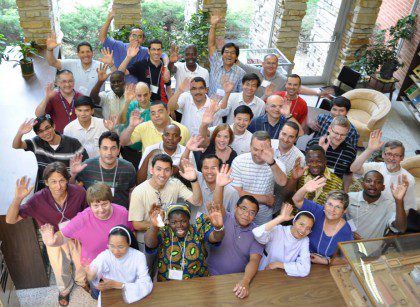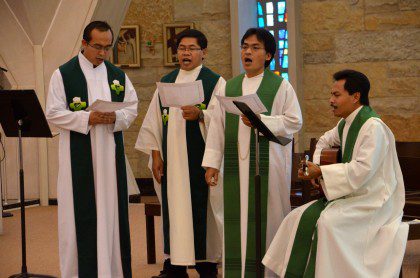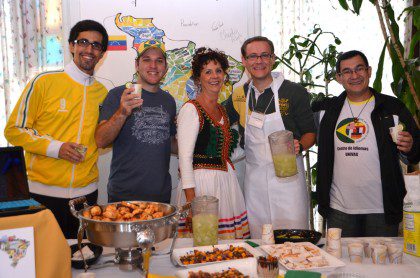
Bishops, curia staff and many others among Sacred Heart’s ESL alumni
There is hardly a community in the congregation that is more international than the ESL community at Sacred Heart School of Theology in Hales Corners, Wis. Approximately 25 percent of the congregation has studied in the program including members of the General Curia and SCJ bishops (among them, the congregation’s most recently ordained bishop: Claudio Dalla Zuanna, SCJ).
“The ESL program is the perfect place to learn about the congregation and about living in another culture,” said Frater Jonathan Schneiders, SCJ. He, and fellow Brazilian Frater Sergio Matumoto, SCJ, were a part of the ESL community in preparation for their current studies and ministry in the Philippines.
“It was the best preparation I could have had for being a part of an international congregation,” he continued. “It was like a ‘little picture’ of the congregation. In the morning I would have breakfast with someone from Indonesia and at lunch I would sit at a table with SCJs from Poland.”
The ESL (English as a Second Language) program began informally in 1986 when a teacher from a Milwaukee university was asked to help prepare an Indonesian SCJ for graduate studies in Chicago. “I worked with him through the summer,” said Allegra Troiano, who now works for the U.S. Peace Corps. “However, I didn’t think of it as the start of a long-term program.”
But soon she received another call and this time it was to help two Polish SCJs learn English in preparation for ministry in South Africa. One of those students went on to become the bishop of De Aar: Bishop Adam Musialek, SCJ. Twenty-five years ago the then newly-ordained priest said something that has been echoed many times since then:
“We are far from home, but still at home. We are among our community. We have the same spirituality, same history of the congregation.”
After the Poles it was an international group of SCJs preparing for the congregation’s new mission in the Philippines. Ranging in age from 28 to 52, they included men from Argentina, Italy, Germany, the Netherlands, Poland, Indonesia and Great Britain. English was to become their common language.

Program established full-time
In 1990 the U.S. Province made a full-time commitment to the ESL program. Sacred Heart Monastery/School of Theology has been welcoming SCJs from around the world ever since.
“The ESL program was very important for me because I was able to improve my English,” said Frater Jonathan. “Academically, it was important. But more importantly we experienced some of the many cultures of the congregation.”
Coming together, often without a common language beyond the English they are all learning, SCJs in the ESL program have a few extra challenges in maintaining community life.
“I don’t speak Spanish, so if I didn’t speak English, Fr. Jésus and I could not communicate,” said Fr. Christoph Cinal, SCJ, a Polish SCJ who was a part of the ESL community during his sabbatical in 2009. Fr. Jésus Manuel Baena Valbuena, a Spanish SCJ, was preparing for ministry in India.

For some who come to the ESL program it is their first time living within an international community. For others, like Fr. Francois “Kiko” Muway, SCJ, of Congo, internationality is all that he has known of religious life. It was this sense of the international Church that he brought to the ESL community.
“In my province, there are people from Italy, Brazil, Poland –– many cultures,” said Fr. Kiko. “Our formation experience in Congo helps us to be international, to realize that we are a part of an international congregation. I can go to an SCJ house anywhere in the world and feel at home because we share the same spirituality; that is our shared culture.”
Fr. Kiko is now provincial secretary of the Congolese Province after spending several years living in yet another international community: the International College in Rome.
“Living in the international ESL community was challenging,” said Br. Roberto García, vice-secretary general. A member of the Spanish Province, he was a student in the 2012 summer program. “However, it brought many good opportunities. It helps a person to see different ways of viewing life, ways different than what a person knows in his own culture.
“For me, one of the most significant parts of living in the ESL community was that I could feel at home on the other side of the world. It wasn’t my country, it wasn’t my culture, it wasn’t even my house, but being with other SCJ confreres made me feel like I was with my own family. It is amazing to go across the world and be received into open arms.”
Students in the ESL community are a mix of SCJs and those who are not a part of the congregation but who often have ties to it. Since the program focuses on ESL instruction for those in Church ministry, it is the perfect setting for seminarians, religious and diocesan priests, as well as religious sisters, and lay people in ministry. The 2012 summer program had 31 students representing 13 countries. The ESL community is smaller during the fall and winter semesters but the international mix is a constant.
“The ESL program is a way for the U.S. Province to support the worldwide congregation through education, but it is also a gift to us,” said Fr. Tom Cassidy, SCJ, provincial superior.
“The world literally comes to our doorstep bringing the international reality of the congregation to life for members of our province,” he said. Seminarians from a variety of dioceses and religious communities also experience the international Church through the ESL program. “They [SHST seminarians] live and pray with our international ESL community. Through them, many windows to the universal Church are opened. Because of this, the ESL program is a vital part not only of our SCJ community experience but the Sacred Heart seminary experience as well.”
Click here to learn more about the ESL program.
NOTE: This article originally appeared on the Generalate’s website, www.dehon.it/en
